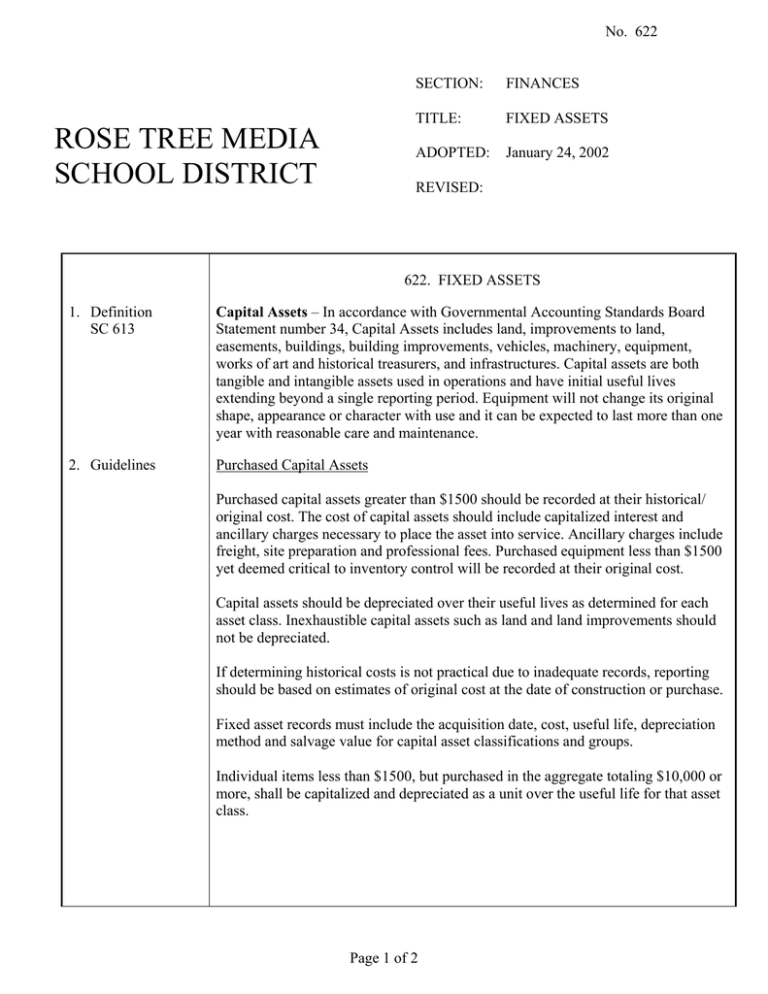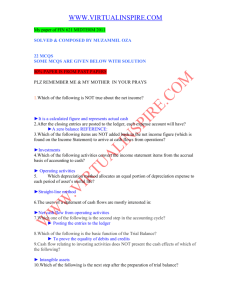ROSE TREE MEDIA SCHOOL DISTRICT
advertisement

No. 622 ROSE TREE MEDIA SCHOOL DISTRICT SECTION: FINANCES TITLE: FIXED ASSETS ADOPTED: January 24, 2002 REVISED: 622. FIXED ASSETS 1. Definition SC 613 Capital Assets – In accordance with Governmental Accounting Standards Board Statement number 34, Capital Assets includes land, improvements to land, easements, buildings, building improvements, vehicles, machinery, equipment, works of art and historical treasurers, and infrastructures. Capital assets are both tangible and intangible assets used in operations and have initial useful lives extending beyond a single reporting period. Equipment will not change its original shape, appearance or character with use and it can be expected to last more than one year with reasonable care and maintenance. 2. Guidelines Purchased Capital Assets Purchased capital assets greater than $1500 should be recorded at their historical/ original cost. The cost of capital assets should include capitalized interest and ancillary charges necessary to place the asset into service. Ancillary charges include freight, site preparation and professional fees. Purchased equipment less than $1500 yet deemed critical to inventory control will be recorded at their original cost. Capital assets should be depreciated over their useful lives as determined for each asset class. Inexhaustible capital assets such as land and land improvements should not be depreciated. If determining historical costs is not practical due to inadequate records, reporting should be based on estimates of original cost at the date of construction or purchase. Fixed asset records must include the acquisition date, cost, useful life, depreciation method and salvage value for capital asset classifications and groups. Individual items less than $1500, but purchased in the aggregate totaling $10,000 or more, shall be capitalized and depreciated as a unit over the useful life for that asset class. Page 1 of 2 622. FIXED ASSETS - Pg. 2 Due to changes in technology, computer software is considered a supply and is expensed at the time of purchase. Components such as monitors, keyboards shall be capitalized as a unit upon purchase when the individual components are less than the capitalization thresh-hold but in the aggregate meet or exceed the thresh-hold. Depreciation Expense Depreciation expense should be reported in the statement of activities. Depreciation expense that can be specifically identified with a function should be included as a direct expense. Depreciation expense for shared facilities should be ratably included in direct expenses for each function. Depreciation is allocated to expense in a systematic and rational manner. The straight line method of depreciation is used. Depreciation may be calculated for a class of assets, a network of assets or individual assets. Disposals Sale of Fixed Assets - When fixed assets are sold, a calculation of gain or loss on disposal is required. The calculation is based upon the amount of proceeds received less the net book value (cost less accumulated depreciation taken on the asset). Trade-ins - The value given for a trade is part of the cost of the newly acquired asset. The costs and accumulated depreciation of the trade-in asset must be removed from the books. Any gain or loss resulting from the disposition of the asset will be recognized as a gain or loss on disposal. Assets Acquired by Capital Lease Assets acquired by capital lease are recorded at the net present value of the future minimum lease payments. A corresponding liability is established at this time. Assets acquired under the terms of capital leases are depreciated over the useful lives designated for the asset class. Page 2 of 2




